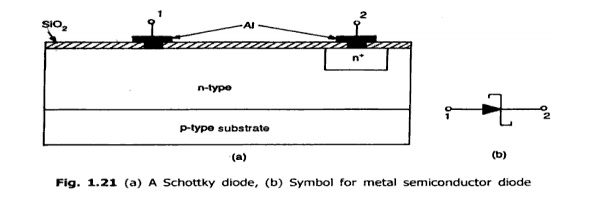The metal contacts are required to be ohmic and no PN junctions to be formed between the metal and silicon layers. The N+ diffusion region serves the purpose of generating ohmic contacts. On the other hand, if aluminium is deposited directly on the N-type silicon, then a metal semiconductor diode can be said to be formed. Such a metal semiconductor diode junction exhibits the same type of V-I Characteristics as that of an ordinary PN junction.
The cross sectional view and symbol of a Schottky barrier diode as shown in figure. Contact 1 shown in figure is a Schottky barrier and the contact 2 is an ohmic contact. The contact potential between the semiconductor and the metal generated a barrier for the flow of conducting electrons from semiconductor to metal. When the junction is forward biased this barrier is lowered and the electron flow is allowed from semiconductor to metal, where the electrons are in large quantities.

The minority carriers carry the conduction current in the Schottky diode whereas in the PN junction diode, minority carriers carry the conduction current and it incurs an appreciable time delay from ON state to OFF state. This is due to the fact that the minority carriers stored in the junction have to be totally removed. This characteristic puts the Schottky barrier diode at an advantage since it exhibits negligible time to flow the electron from N-type silicon into aluminum almost right at the contact surface, where they mix with the free electrons. The other advantage of this diode is that it has less forward voltage (approximately 0.4V). Thus it can be used for clamping and detection in high frequency applications and microwave integrated circuits.

